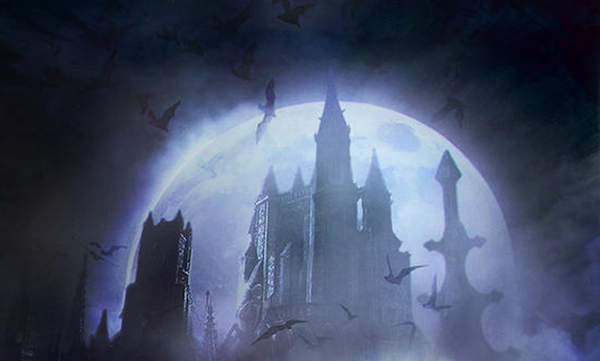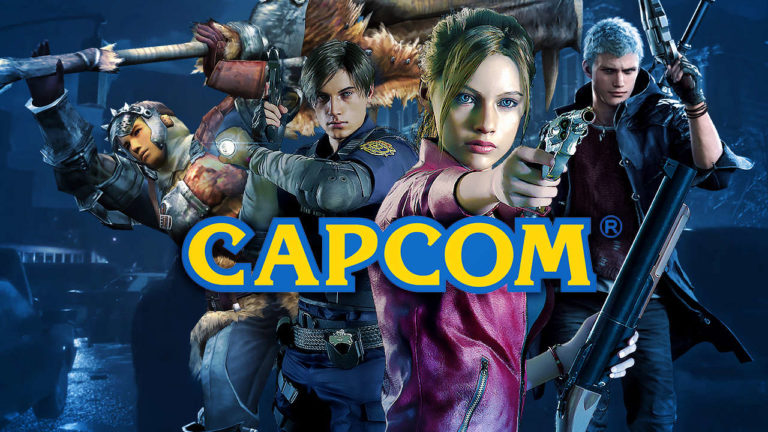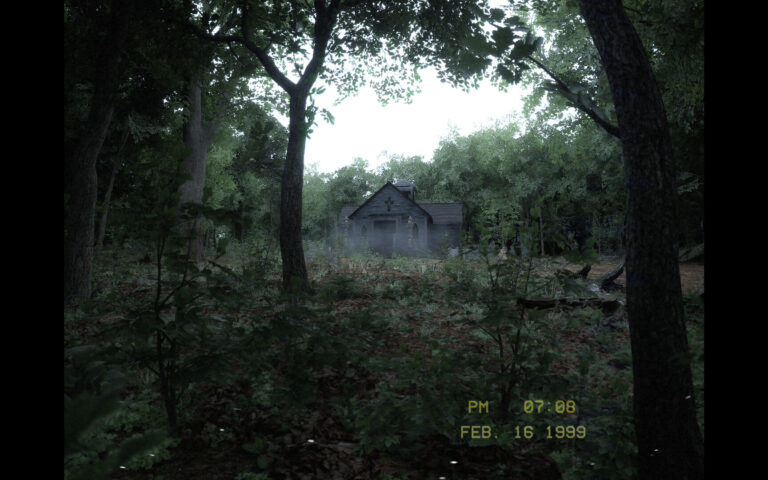
Warning: This article contains spoilers for Castlevania: Lords of Shadow and its DLC. You’ve been warned! So now, have at you!
An armored warrior, whip in hand, stands in front of a large, eerie castle covered in fog, surrounded by pure darkness. A castle that’s an entity in and of itself, able to change its own form, thwarting any attempts to memorize its innards. Bats circle the edifice, this hell on Earth. Its gothic architecture is illuminated by the pale moon behind it, along with rounds of lightning. Dracula and his creatures of the night call this dreadful place home.
Welcome to Castlevania
You can’t have a Super Mario game without Mario. You can’t have a Resident Evil game without evil residents. And you can’t have a Castlevania game without…Castlevania.
The series is named after Dracula’s castle, which plays just as important a role as its lord and the main characters that whip and slash their way through its interior. Granted, some entries in the series aren’t set entirely in the castle, but its presence looms large regardless. It’s just as important as the town of Silent Hill is to Konami’s beloved survival horror series of the same name.
So you can imagine why some fans weren’t too happy about castle exploration being kept at a minimum in Lords of Shadow. “This isn’t my Castlevania!” That was a common remark by many fans who were upset about action playing a bigger role than exploration in the game. They wanted to spend hours exploring every possible nook and cranny in Dracula’s castle, like they did in Symphony of the Night and the GBA and DS games that followed and utilized its design template. But Symphony of the Night this was not.
Many fans have become accustomed to the Symphony of the Night style of Castlevania over the years . They were expecting the same from Lords of Shadow. Perhaps not the RPG mechanics, but definitely a large amount of nonlinear castle exploration. So they were certainly taken aback by Lords of Shadow’s more linear action-heavy approach.
Lords of Shadow was inspired by the original NES games in the series, with Super Castlevania IV also being cited by producer Dave Cox. Those 2D classics didn’t automatically pit players in the castle from the get-go. Instead, it was all about the journey to said castle. These adventures were linear in nature, save for Castlevania II: Simon’s Quest. They were all focused on action and platforming. And with the actual castle not being traversed until later in each game, the best was always saved for last.
The same applied to Lords of Shadow, albeit with a big twist.

The game showed us Dracula’s tragic origins as players took on the role of Gabriel Belmont. So, logically, Dracula’s castle still wasn’t a thing. There was a castle, though, but at the time of Gabriel’s arrival later in the story, it belonged to the Lord of the Vampires, Carmilla.
Lords of Shadow is the very definition of an epic journey, and it all payed off once we got into the iconic castle, despite being under different ownership. I remember the first time I made it out of Wygol village after fighting Brauner, the massive castle was clearly visible. It sent chills down my spine. I made Gabriel just stand there for a good minute or two. I was admiring the view. It got even better and nostalgic once I made it inside, thanks in large part to Mercury Steam’s brilliant art direction. I didn’t want to leave.
There was no upside down castle or anything crazy like that, but battling Carmilla’s forces and confronting her “daughter” Laura made for some memorable moments during one’s stay at the castle. The battle with Frankenstein’s monstrosity also comes to mind. Though I would’ve loved to fight The Creature, I was happy with this mechanical baddie. What’s more, the “Resurrection” DLC revolved around Gabriel’s fight with one of the game’s best bosses: The Forgotten one – a powerful demon who had been imprisoned in the castle, sealed away in another dimension by the founders of the Brotherhood of Light.
There was no way to get lost, or secret areas out of the beaten path to explore akin to the Symphony of the Night style games for that matter, but Lords of Shadow’s castle segments truly harkened back to those NES classics. The main hall, sewers, laboratory, clock tower and throne room were all here, and it was all beautiful and downright glorious. And in the end, the chapters set in the castle combined to feel like its own separate game. Of course, everyone’s assumption was that we would face Dracula in the famed throne room, but this wasn’t the case. That’s where the twist comes in.
Mercury Steam was clever by giving Gabriel the same feeling of confusion as the player after Laura referred to the lord of the castle as a “she”. Is this Metroid all over again?! Not exactly. But players were surprised to see that the final boss in the castle wasn’t Dracula. But just how the entire game served as Dracula’s origin story (in the Lords of Shadow universe, of course), Gabriel’s arrival at the castle and Carmilla’s defeat by his hand was also the first step in making the castle his own fortress, unbeknownst to him. Gabriel wasn’t yet aware of his true and tragic fate.

Speaking of origin. The castle itself also got a little bit of backstory in the game as well. Carmilla actually stole ownership of the castle from the Bernhard family. During the family’s reign in the castle, Friedrich Von Frankenstein was also residing there. At one point in time, the castle wasn’t the hell on Earth it was when Gabriel entered it. Though we don’t know who the previous owners were. What we do know is that it was the Bernhard family that led to the castle being possessed, thanks to their pact with a demon, which also led to summoning of The Forgotten One.
Carmilla then decided to make the castle her own. She stripped the Bernhards of their ownership, but she opted to keep Frankenstein for herself. She would inflict torture on the poor doctor, forcing him to keep working on his monstrosities for her. And thus begun Carmilla’s reign, as she unleashed vampiric hordes within the castle.
So as Gabriel ascended that iconic staircase, combat cross in hand, Carmilla was anticipating his inevitable emergence in her throneroom. It was a brilliant boss battle that ended the castle segment of the game on a truly high note. But unlike most Castlevania games that end once you slay the final boss in the castle, Gabriel’s journey wasn’t over yet. After the events of the game and its DLC, Gabriel would eventually make the castle his own, after absorbing Laura’s and The Forgotten One’s powers. He is now Dracula, and Castlevania is his home.

So now let’s focus on the second part of Mercury Steam’s Lords of Shadow trilogy: Mirror of Fate, which will be released exclusively on the 3DS on March 5th in North America. Dracula’s castle (it’s actually now his castle) will play a huge role in the game, with it serving as the main setting for much of the game. But once again, like in the first game, there’s a twist.
First, it’s worth stressing that Mirror of Fate isn’t intended to be a Symphony of the Night style game in terms of exploration. Yes, there will be many areas to explore in the castle (and its exterior), and there will be backtracking, but as far as exploration goes, Mirror of Fate’s will be more in line with Alucard’s debut title: Castlevania III: Dracula’s Curse. This NES classic had branching paths, which is a feature Mirror of Fate adopts, along with the multiple character system.
There are four (known) main playable characters in Mirror of Fate: Gabriel, Trevor, Simon and Alucard. Each will possess their own special ability, which will not only complement combat, but it’ll also affect exploration of the castle itself. There are some areas only a certain character will be able to access. Like, for example, Simon with his double-jump ability. This not only grants him greater evasion during combat, but also lets him reach areas that are inaccessible to others. But wait, it gets better.
Each main character will be playable in their own specific timeline. Which means that the castle will change with each time jump we make. Not only that, but actions that one character performs in one particular timeline that alters an area of the castle will be reflected in another character’s visit. Basically, we’ll be witnessing the evolution of the castle as years pass. But, of course, at the heart of it all is Dracula, waiting to challenge us just how Carmilla waited for Gabriel in her throne room all those years ago. But this time it’s personal, since in this universe Dracula is actually Trevor and Simon’s ancestor, a Belmont himself.
So now a Belmont, sent by the Brotherhood of Light, stands in front of Dracula’s castle. He grips his combat cross, bracing himself for the horrors he’s about to face inside. His name is Trevor. He will not rest until he exacts revenge on Dracula, his father, for the death of his mother. But is a horrible fate also waiting for Trevor? Will he get to see his wife, Sypha, and his son, Simon, again? Perhaps this is all just a grand homecoming for the son of Dracula.
What a horrible night for a house party…

 JBoc924
JBoc924


